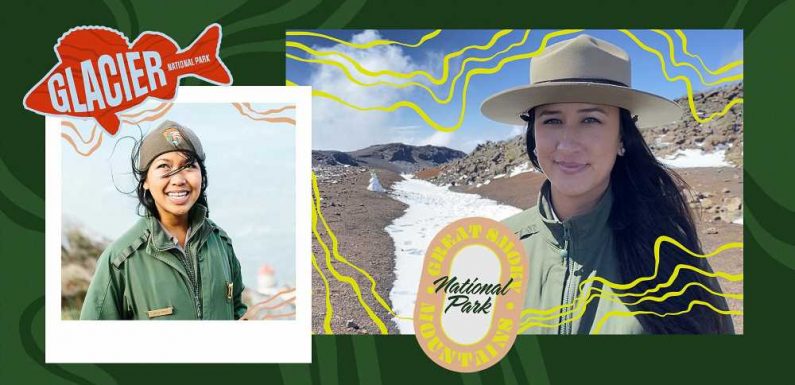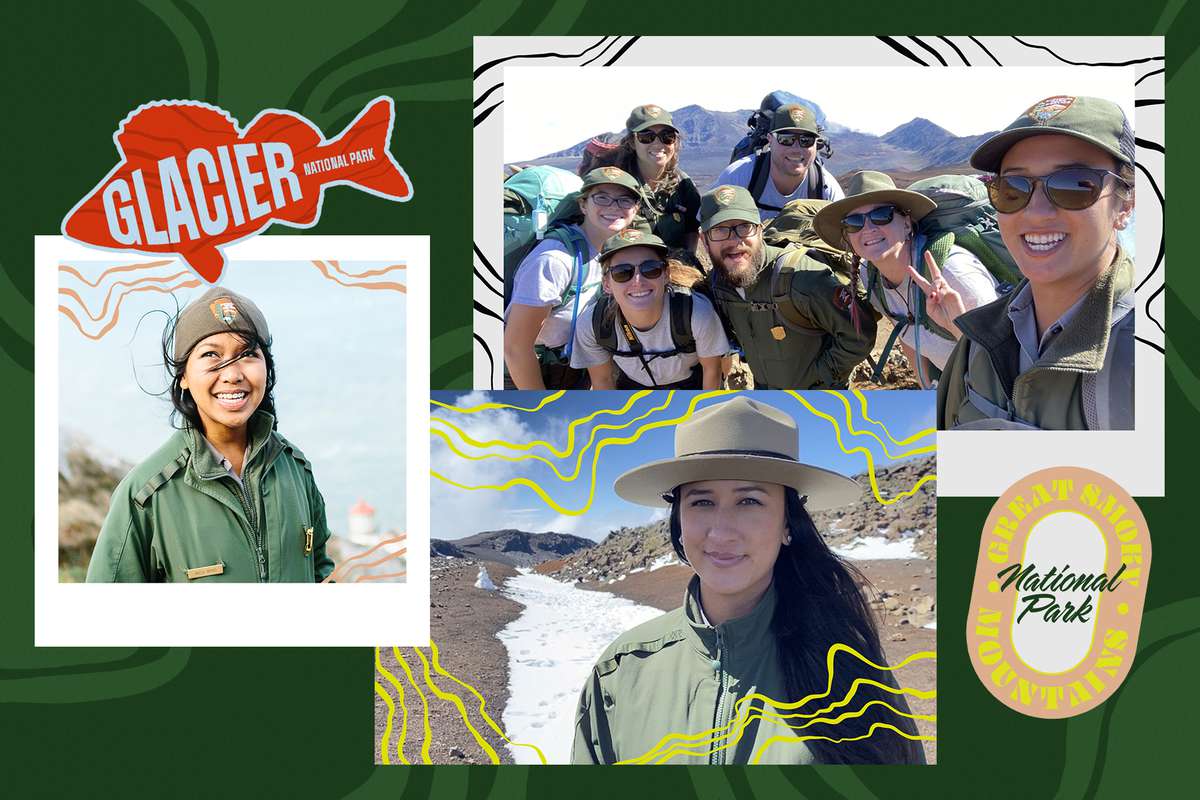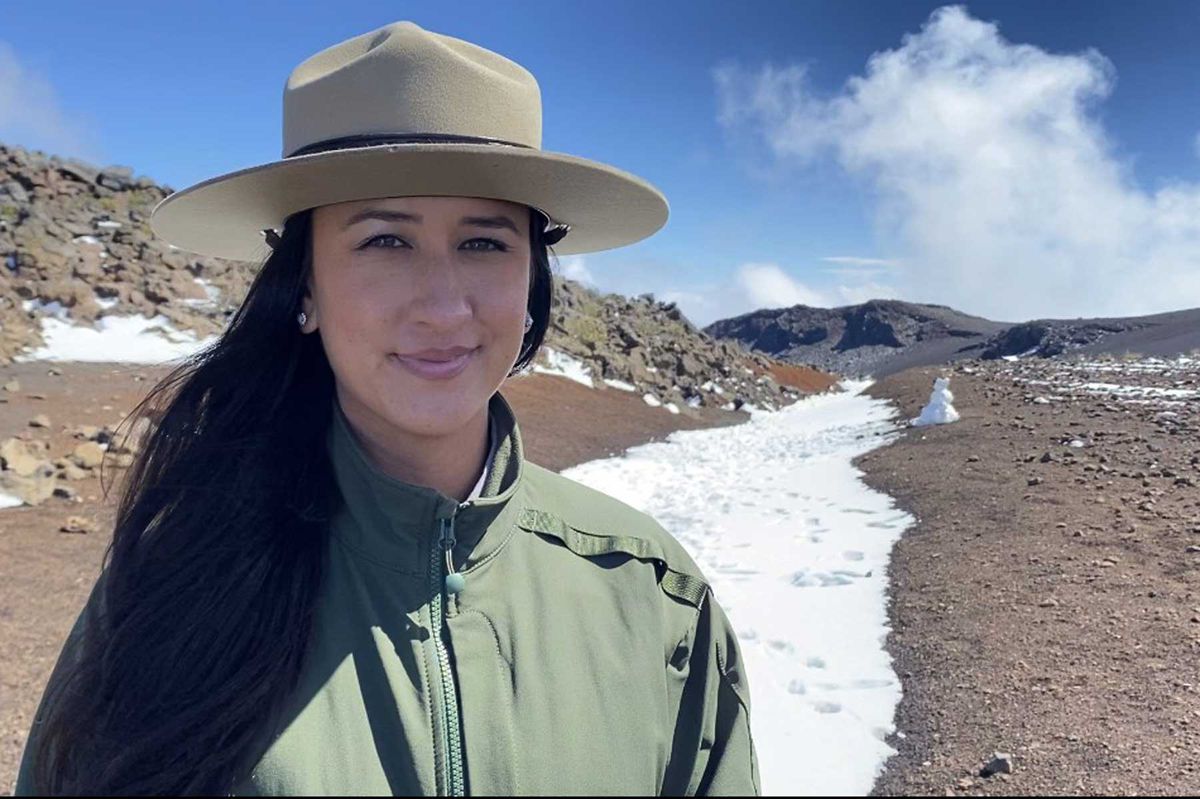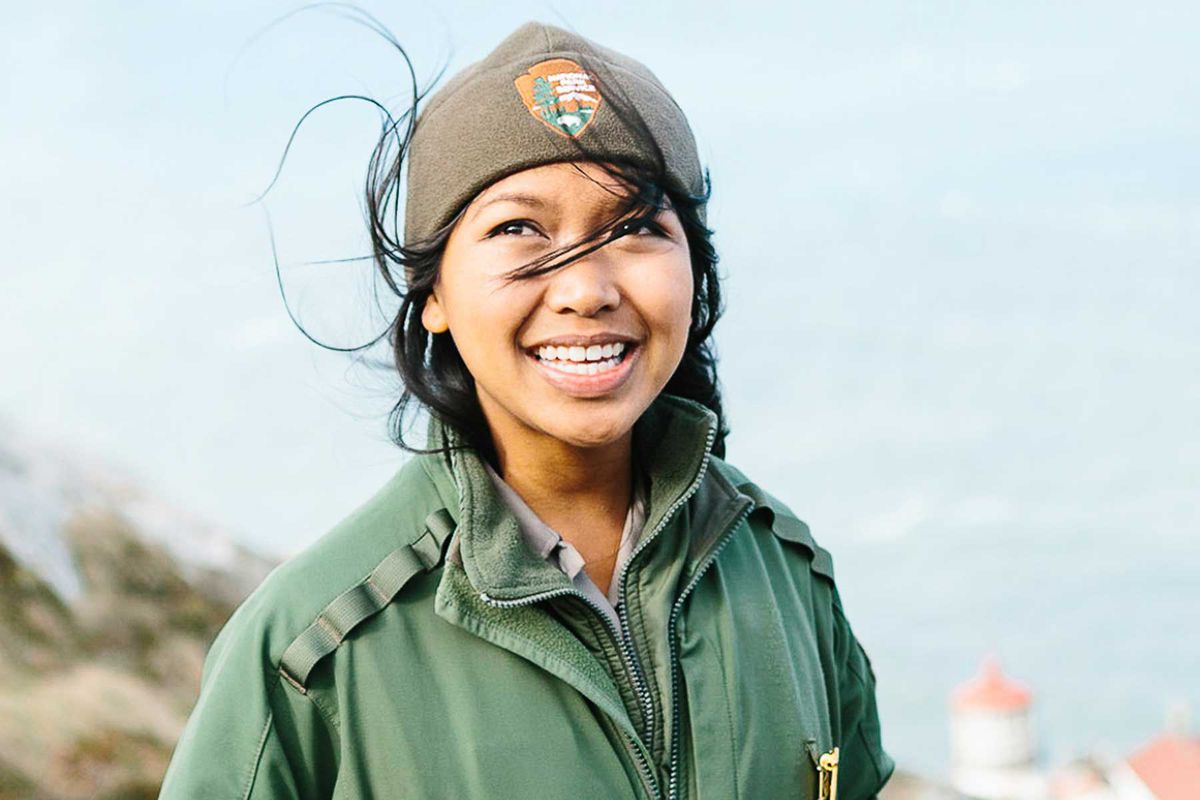
From a love of the outdoors and a desire to protect park lands to a calling to educate the public, there are many reasons people are inspired to be rangers in the U.S. National Parks. The National Park Service's first official female ranger (called a rangerette at the time) was a temporary hire in 1918 to fill a vacancy left by a man who responded to the United States' call to arms to serve in Europe during World War I, and early on, most female rangers only held job titles such as naturalist or visitor youth assistant. We've come a long way since the time when women were excluded from service or relegated to "appropriate" jobs, and today, women can be found serving in jobs across the National Park Service.
Meet three women who are proud to wear the park ranger's flat hat on behalf of the National Park Service: Jin Prugsawan (Haleakalā National Park), Jessica Ferracane (Hawaiʻi Volcanoes National Park), and Alena Kopshever (Point Reyes National Seashore).
Jin Prugsawan, Chief of Interpretation & Public Information Officer, Haleakalā National Park
Travel + Leisure: What is a day on the job like for you?
Jin Prugsawan: "Each day for a park ranger may be a little bit different, especially during this past year, when we focused on ways to virtually engage people through our website and social media, as well as on the trails where we can properly socially distance. Typically, park rangers at Haleakalā National Park spend time in the visitor center helping people plan their experience or answering questions about some of the things there are to see and do.
We also offer a variety of programs, from pointing out constellations in the exceptional glittering night sky over Haleakalā to talking about the unique species of forest birds, some of which can be found here and nowhere else. Park rangers also visit students in their classrooms where we talk about geology found in the park or take students on a field trip to the park to plant native species. There's behind the scenes work too, like maintaining the park's website or creating new signs and exhibits for people to learn more about the park."
What does your career path look like?
"I found the National Park Service early in my life and at a very formative time. I started my internship with the NPS when I was 18 years old during my senior year of high school. Coming from a single-parent household, having a job at an early age was a necessity. I worked in retail and other odd jobs, but I saw my internship as a pathway to a career opportunity. The more I learned about the NPS during my internship, the more excited I was at the thought of becoming a park ranger. Following high school graduation and my enrollment at George Mason University, I officially became a park ranger at Arlington House, the Robert E. Lee Memorial.
I'll never forget the moment when I put on my flat hat for the first time. I felt so proud to be a part of the NPS, and I still am. Since then, my career has taken me all over the country where I've been fortunate to have worked at some of the crown jewels and hidden gems in the U.S. National Park system. Parks at which I've worked include Hawaiʻi Volcanoes National Park, Yosemite National Park, Great Falls Park, Zion National Park, Wright Brothers National Memorial, Fort Raleigh National Historic Site, Cape Hatteras National Seashore, and now Haleakalā National Park."
Are there any challenges you've faced as a woman in your field?
"Early in on my career, I attended a training where a startling statistic was shared: 'The majority of people in mid-level management positions in the NPS are filled with white males over the age of 40.' I was 22 at the time. I am half Asian and half white, and that statistic still makes me feel unfairly disadvantaged. As an agency, the NPS has work to do regarding diversity and racial equity. There are a lot of people out there who are actively trying to change this, including me, and I look forward to finding more opportunities for diverse people to feel welcomed and have opportunities in national parks.
Today, not only do I find myself in a leadership role at the age of 32, but I am also surrounded by more diverse people in age, ethnicity, and gender than I ever have been before in my career. I am inspired by the people I work with at Haleakalā National Park, many of whom are women in the role of supervisors and program leads, including the park's superintendent."
What do you love about your job?
"What appealed to me about the National Park Service and keeps me here has always been the people I am so fortunate to work with and meet in our parks. Along the past 14 years of my career, I have met some incredible and inspiring people. From the women and men who are on the forefront of studying climate change in our parks to the young park visitor who for the very first time is seeing the Milky Way. I feel very lucky to have a career where people care about the environment and natural spaces, are dedicated to shedding light on the untold stories of diversity in our parks, and in a place that our nation has collectively decided is worthy of protecting for future generations."
What makes your park unique?
"I love the diversity at Haleakalā National Park. From sea to summit, Haleakalā rises 10,023 feet in elevation. It supports diverse ecosystems from lush rainforests to high alpine desert. It's a place so unique that many of the plants and animals here are found nowhere else in the world. At Haleakalā National Park, you not only get to see these incredible places, but you are able to learn about why they are sacred. From learning about the first Polynesian settlers to the vibrant living Native Hawaiian culture today, there are lots of sacred places, stories, and links that connect the past and the present. Not only is Haleakalā National Park protected by the mission of the National Park Service to preserve and protect but it is also guided by the Native Hawaiian principle of mālama 'āina (caring for the land), it's wonderful to see how many people truly care for this special place."
Do you have an expert national park tip?
"Be flexible and have a back-up plan. I love working in national parks as well as visiting and exploring in them. I plan ahead by visiting nps.gov to find great hikes or cool points of interest. I make sure to have a few options of what I'd like to do or where I would like to go. That way, if something happens that I didn't anticipate like poor weather or an unexpected trail closure due to rockfall, I have great backup plans. Some of the most memorable experiences I've had in national parks have been a backup plan or unexpected adventure."
Is there a hidden gem at your park?
"Kalahaku Overlook is often not crowded, especially at mid-day, and many people pass it on their way up to the summit. About 10 years ago, when I first came to Maui on vacation, I remember wondering if the long drive and winding road up to Haleakalā's summit would ever end. Shrouded in clouds and even some light rain, it was unclear if we would be able to see anything. Luckily, as we drove through the park, we started to make our way above the clouds. There were a lot of shrubs mixed in with the volcanic landscape, but no signs of the crater itself. We finally reached the turn for Kalahaku Overlook and were met with our first views of Haleakalā crater. I remember being in awe of all the colors — deep red, browns, tans, and even purple. To me, it looked like what I imagined Mars would look like. In addition to great views of the crater, you can also see the ʻāhinahina (silversword) plant found on Haleakalā and nowhere else in the world, and maybe even an ʻuaʻu (Hawaiian petrel) nesting in this area."
Jessica Ferracane, Public Affairs Specialist at Hawaiʻi Volcanoes National Park
Travel + Leisure: What is a day on the job like for you?
Jessica Ferracane: "It is never the same day twice when you work in a park with two active volcanoes! I've worked in Hawaiʻi Volcanoes National Park for 10 years, and Kīlauea has had many different eruption episodes, everything from lava pouring into the ocean and building new land, to fissures on its flanks unzipping and sending curtains of molten rock skyward, to hosting the world's largest lava lake in its summit crater. Working here is indescribably exciting, but there are times that I crave a 'slow news day' for the park and our community. Visitors love seeing volcanoes do their thing, and part of the park's mission is to provide safe access to active volcanism, but there are very real hazards that I'm in charge of communicating to the public. That top message is to stay out of closed areas. Volcanic gasses and particulates impact air quality, newly formed lava benches can collapse, there are earth cracks and steep cliffs that pose significant risk and can result in death. Besides Kīlauea, there is also the sleeping giant of Mauna Loa to consider. It's the world's largest active volcano, but is not currently erupting. It will erupt again, and there have been times, like in 1984, that both volcanoes were erupting at the same time."
What does your career path look like?
"Like many communications professionals, I started off in journalism. I worked as a newspaper reporter, then started freelancing. I had to update a section on Hawaiʻi Volcanoes National Park for a guidebook and visited the park for the first time in 1994, on assignment. Lava at that time was pouring into the ocean at Kamoamoa. (That's the former black sand beach where Chris Isaak's 'Wicked Game' video was filmed. The beach was consumed by lava shortly thereafter.) I could not believe my eyes! The park rangers showed us how to safely observe the lava flowing down the steep cliffs, across the coastal plain, and into the water. I was smitten. I met my predecessor and dreamed that one day I could have that job, but she wasn't going anywhere. Who would leave the best job in the world, right? I eventually went into public relations for the Hawaiʻi tourism industry, and she finally retired in 2011, right before another significant eruption. I was called in as an emergency hire to help the park inform the public about the new eruption, and the rest is history."
Are there any challenges you've faced as a woman in your field?
"I am fortunate that I have not personally experienced any gender-based challenges in my field, but I am well aware of the challenges other women have faced in the workplace and I am committed to helping my colleagues who experience that. I think one of the challenges we all face as women is trying to do it all — at work, at home, in our personal lives. It's important to achieve balance and allow ourselves to rest and restore, and not get in our own way."
What do you love about your job and/or your specific park?
"I love working in a place that has such an incredibly profound cultural significance to native Hawaiians and many others who are connected to the sacred landscapes here. Early Hawaiians were keen observers of their natural environment, and parlayed geologic events into mōʻōlelo, or stories, that explained what was happening. One of the most compelling mōʻōlelo is the story of how Pele, the volcano deity, sent torrents of lava to destroy her sister's forested domain in a jealous rage. That mōʻōlelo describes an actual eruption of Kīlauea more than 500 years ago that sent lava from the summit of Kīlauea into the forested areas below, destroying them. Hawaiians have a way of bringing these geologic happenings to life, and the park is imbued in these stories from the summit of Mauna Loa to the coastal reaches of Kīlauea."
Do you have an expert national park tip?
"A lot of our visitors donʻt realize that the summit of Kīlauea is at a 4,000-foot elevation and can be quite chilly and rainy at times. They come over from the warm resort areas dressed in flip flops and shorts and tank tops and they freeze! Be prepared. You should dress in layers to get the most out of your visit, as our elevation and climate zones vary. Hawaiʻi Volcanoes National Park is best explored on foot, out of the car, and on the trails. The first stop all visitors should make is the park website. The website gives you all the info you need to prepare for your trip, including current eruption status, any closures, what to bring, wearing a mask, how to recreate responsibly, and more."
Is there a hidden gem at your park?
"The park is open 24 hours a day, which is something many visitors don't know. To me, the best time (and least crowded time) to view the current summit eruption is before the sun comes up. Kīlauea Overlook is 'overlooked' in the wee hours, but in the early evenings it can get very crowded. Set your alarm and get here early. You wonʻt be disappointed. After you view the summit eruption, you can drive the 19-mile Chain of Craters Road from the summit of Kīlauea to the coast, stopping to explore the numerous craters from past eruptions on your way down to a magnificent sea arch."
Anela Kopshever, Interpretive Park Ranger at Point Reyes National Seashore
Travel + Leisure: What is a day on the job like for you?
Anela Kopshever: "It depends on the day! Before COVID, I spent most days working at one of three visitor centers in the park. I help visitors plan their trip to the seashore and answer any questions they might have about the area. I give programs for the public on a variety of topics like the historic Point Reyes Lighthouse or gray whales migrating past the Point Reyes Headlands. Some days, I give education programs for students on the First People of Point Reyes, the Coast Miwok. Ultimately, my job is to help people understand and care about Point Reyes National Seashore."
What does your career path look like?
"I would have never thought that I would end up as a National Park ranger. I am a first-generation Filipino American and my parents were not nature fans. We didn't hike or camp as a family when I was little. And we definitely did not visit national parks. I moved away for school, and I studied Biology in college and got sidetracked by environmental science. My classes brought me hiking and camping in New Zealand and all over California. I was sold. I knew I wanted to work outdoors. I landed a summer botany internship with Santa Monica Mountains National Recreation Area in my senior year. I was hired for my first seasonal interpretive park ranger job after graduation. Since then, I have worked as an interpretive park ranger at Santa Monica Mountains National Recreation Area, Katmai National Park and Preserve in Alaska, and Point Reyes National Seashore. Now my parents visit national parks with me! I'm thrilled that I can share my love of nature with them and others."
Are there any challenges you've faced as a woman in your field?
"I started with the National Park Service when I was 21 years old. Perhaps it was age or gender, but there have been a few times when visitors preferred to receive information from the older, white, male ranger standing next to me. I feel fortunate that my peers have always stuck up for me, indicating that I wear the same ranger hat and badge, and that I know just as much as they do."
What do you love about your job?
"I love the connections that come with being a park ranger. First, there's a connection to people from around the world who have a genuine curiosity for the park. I get to share in the 'ooh' and 'aah' moments when a visitor first sees a gray whale exhale, or when they peer up at the glimmering, first-order Fresnel lens at the lighthouse. It is so special to witness that 'aha' moment almost every single day. Second, there's this intense personal connection to the park. I love that I get to observe the ebb and flow throughout the seasons. Like, elephant seals arriving for the mating and pupping season in the winter, and when they leave to forage in the spring. Or when the winter rains transform the hills to emerald green and seeing the earth exhale in summer to a brilliant gold. You get to really know the bones of a place. It's not just a place that you visit, it's home."
What makes your park unique?
"I love the solitude at my park. For being a little over an hour away from San Francisco, there are more than 33,000 acres of wilderness in Point Reyes National Seashore. You can easily get away from it all, whether it's watching the sunset on a secluded beach, hiking more than a hundred miles of trail through forested ridges or coastal brush, or observing the charismatic wildlife that thrives in this area — tule elk, elephant seals, bobcats and coyotes, to name a few. "
Do you have an expert national park tip?
"Plan a trip for off-season, mid-week, or early mornings to beat the crowds. The secret is out that parks are amazing, beautiful places to visit and there are unending benefits to spending time outdoors. You can have trails and entire beaches to yourself if you visit during off-peak times. With COVID, face masks are required in all buildings and facilities and in areas where physical distancing cannot be maintained. Also, nps.gov is the best place to get information for future park visits."
Is there a hidden gem at your park?
"It's hard to answer this one, because it won't be so much of a secret! But there is a magical world in Point Reyes that is only available to us several times a year. At the lowest of tides (a negative low tide is best), the ocean retreats and the intertidal zone is revealed. Creatures like sea stars, barnacles, giant green sea anemones, and more are exposed. Just be sure to check the tides, never turn your back on the ocean, and tread lightly while discovering the many creatures and treasures of the tidepools."
Source: Read Full Article













